Money laundering schemes: methods, examples, and how they’re detected
- azakaw

- Jun 4
- 12 min read
Updated: 2 days ago
Money laundering schemes: methods, examples, and how they’re detected
One of the most serious financial crimes of our time is money laundering.
Financial criminals, like drug cartels and hackers, use money laundering schemes to hide where their illegal money came from and put it back into the legal economy. But how do these plans work? What are the most common ways to launder money, and how are banks and law enforcement agencies fighting back?
This guide goes into detail about the different ways to launder money, including its stages, types of schemes, real-world examples, international cooperation, and how Anti-Money Laundering (AML) measures help catch and stop illegal activities.
Money Laundering Methods - Key Takeaways |
|
|
|
|
Understanding money laundering
What is money laundering?
Money laundering is the act of making it look like money that was gotten illegally came from legal sources.
To prevent this financial crime, it's important to teach professionals and the general public about the different methods of money laundering.
The impact of money laundering
Money laundering has effects that go far beyond the people who do it.
Economic distortion: Launderers can artificially raise property prices and make fair competition less likely by putting illegal money into markets like real estate.
Funding crime and terrorism: People often use laundered money to pay for more illegal activities, which keeps the cycle of crime going.
Breaking trust: When banks or other financial institutions get into trouble, people lose faith in them.
Companies that get caught up in money laundering schemes can lose credibility, face fines, and other penalties.
These effects are so big that we need to work together around the world to stop money laundering.

How money laundering works: the 3 stages
Money laundering can be explained in simplistic terms as comprising three steps: placement, layering, and integration.
Placement
This is where the illegal money enters the financial system for the first time.
Criminals can deposit money in banks, transfer money through money mules, or transfer money across borders with cash.
The idea is to introduce dirty money into circulation in a manner that would not raise any alarm.
Layering
After being put in place, the money is then layered, meaning it’s integrated in complicated financial dealings that are meant to hide the source.
This may include the movement of money between different accounts, forgery of invoices, or cryptocurrencies and shell companies.
Read also: The importance of KYC for crypto exchanges
Integration
In this third stage, laundered money is reintroduced into the legitimate economy.
Criminals might invest in real estate, businesses, or luxury assets, which makes the money appear as if it were earned legitimately.
At this stage, tracing the funds back to illegal activities becomes extremely difficult.
TIP: Read our ultimate guide about Anti-Money Laundering in Real Estate
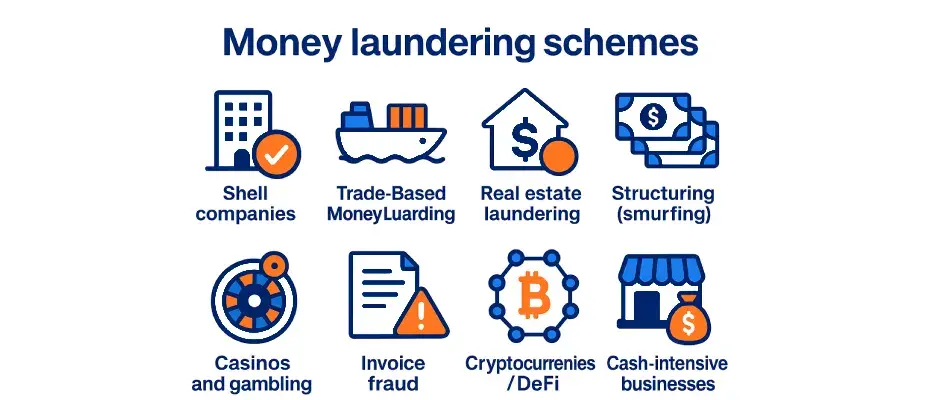
Types of money laundering schemes
There’s a wide range of methods that criminals use to launder money. Below are the most common types of money laundering schemes.
Shell companies and fake corporations
Criminals create companies that don’t actually have real operations, and they use them to move money under the guise of legitimate business.
This is one of the most common ways to illustrate how to clean dirty money: funds appear to pass through legitimate transactions, but in reality, they are being laundered.
Beneficial ownership is often concealed, which makes it difficult for authorities to identify the real individuals controlling these companies.
Trade-Based Money Laundering (TBML)
From our compliance work, we know that trade-based money laundering (TBML) is one of the most complex and, unfortunately, effective methods that criminals use to launder illicit funds.
It takes advantage of the scale and complexity of global trade, where millions of shipments and invoices are processed across different jurisdictions every day.
By manipulating trade documents, criminals are able to move large sums of money while giving transactions the appearance of being legitimate.
In practice, TBML can appear in several ways:
Over-invoicing: the value of goods is deliberately inflated so that more money can be transferred abroad under the cover of a “normal” payment.
Under-invoicing: goods are declared at a much lower price, allowing value to be shifted quietly to another party.
Phantom shipments: invoices are issued for goods that never move, creating a paper trail to justify illicit payments.
Multiple invoicing: the same shipment is invoiced more than once to explain repeated transfers.
What makes TBML so difficult to detect is not just the falsified paperwork, but the environment in which it happens. Trade involves different customs systems, currencies, and regulators, which creates opportunities for gaps and inconsistencies.
In many FATF mutual evaluations, TBML has been highlighted as a persistent weakness because it is hard to monitor across borders.
We also see it combined with shell companies and offshore structures, which obscure beneficial ownership and make enforcement even more challenging for authorities and financial institutions.
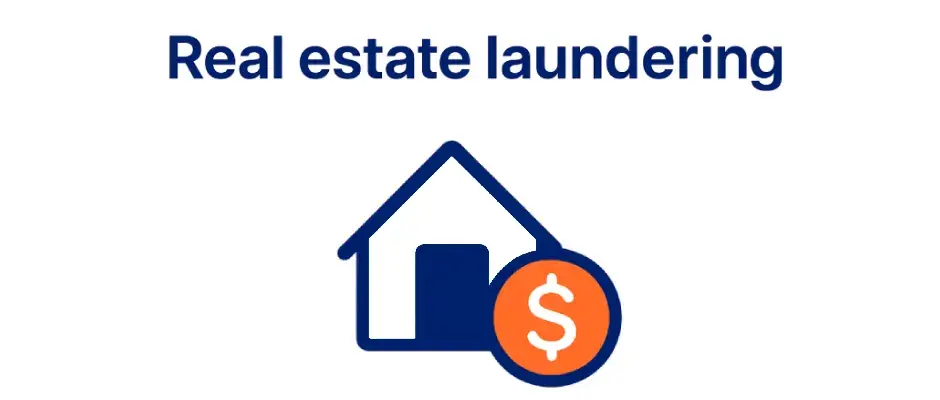
Real estate laundering
From our years of experience in compliance, we know that real estate is one of the most commonly used money laundering techniques.
The sector naturally attracts illicit funds because properties are high-value, transactions can move across borders, and ownership is often less transparent than it should be. Criminals benefit from that mix to make dirty money look clean.
A few examples of money laundering through real estate we’ve seen or regulators have flagged include:
Buying property with illicit money: simple but effective, especially when payments are structured to look like legitimate investments.
Rolling over properties: buying and selling the same asset several times so that illegal funds appear as profits from resale.
Manipulating valuations: overpricing or underpricing properties to shift money without raising immediate red flags.
Hiding behind offshore structures: using shell companies, nominees, or trusts to conceal who really owns the property.
These are not rare scenarios. FATF and regulators in places like the EU, UK, and UAE repeatedly warn that real estate remains a high-risk sector.
We’ve also seen cases where firms were fined heavily because they didn’t verify the true beneficial owner or failed to question a property deal that was clearly inconsistent with the client’s profile.
That’s why thorough customer due diligence, source-of-funds checks, and continuous monitoring are essential if firms want to stay on the right side of the law.
Structuring (smurfing)
Structuring, often called smurfing, is one of the oldest ways to launder money, and regulators still see it all the time.
The idea is simple: instead of moving a large sum of illicit money in one go, which would attract attention, criminals break it into many smaller transactions that slip under reporting thresholds.
For example, we’ve seen cases where individuals deposit just under the limit in different bank branches, or use multiple accounts to move money gradually.
On its own, each transaction looks harmless. Put together, however, it’s clear that the funds are being layered to disguise their origin.
Examples of money laundering through structuring include:
Cash deposits are made daily in small amounts, just under the reporting limit.
Multiple individuals (“smurfs”) working together to split up and move large sums.
Use of prepaid cards, money orders, or even crypto wallets to spread the flow of funds.
Regulators such as FinCEN in the US and FIUs across Europe and the UAE regularly warn firms to look out for this behaviour.
Suspicious patterns like repeated deposits at odd hours or funds moving across dozens of small transfers often trigger investigations.
In practice, financial institutions are expected to use transaction monitoring tools to connect these dots, since criminals rely on the hope that no one is watching the bigger picture.

Casino and gambling-based laundering
Casinos and online gambling platforms are another classic channel criminals use to disguise illegal money.
The process is straightforward: funds are brought in as cash, converted into chips, gambled just enough to avoid suspicion, and then cashed out as so-called “winnings.”
On paper, it looks like legitimate gambling income; in reality, it is simply money laundering.
Examples of this technique include:
Buying large amounts of chips with illicit funds, placing a few small bets, and cashing out most of the value.
Using multiple players to spread transactions across tables or digital platforms.
Exploiting online casinos in jurisdictions with weaker AML supervision.
Regulators now require casinos to apply KYC checks to verify player identity, source of funds, and monitor unusual betting behaviour.
In our compliance reviews, we often see that failures occur when casinos don’t properly document who bought the chips or when patterns of behaviour are ignored.
Some common red flags for gambling-related laundering include:
Customers consistently buy chips in cash and cash out quickly with little play.
High-value transactions by players with no clear income source.
Repeated use of third parties to buy or cash out chips.
Authorities from the FATF, FinCEN in the US, and regulators in the EU and UAE all highlight casinos as high-risk environments for laundering.
For compliance teams, the challenge is connecting behaviour that may look normal in isolation but, over time, reveals clear misuse of the system to launder illegal money.
Invoice fraud and over-/under-invoicing
Among the different types of money laundering, invoice manipulation remains one of the most widespread.
It usually appears as a fraud scheme where criminals alter the value of invoices: inflating, deflating, or falsifying them altogether, to justify the cross-border movement of funds.
Unlike some methods that attempt to conceal the nature of the transaction, this technique relies on paperwork that appears legitimate but is deliberately distorted.
Read also: Most common types of fraud
Examples include:
Over-invoicing: exaggerating the value of goods or services so that excess funds can be transferred abroad.
Under-invoicing: declaring goods at a lower value to quietly shift money to another party.
False or duplicate invoicing: creating paperwork for goods that never move, or issuing multiple invoices for the same shipment.
Our experience shows that regulators treat invoice manipulation as a serious financial crime, not only because it facilitates money laundering, but also because it distorts trade flows and harms legitimate businesses.
Detecting this kind of activity requires more than checking numbers. Compliance teams are expected to use risk-based monitoring, verify counterparties, and question transactions that don’t align with market prices.
Without this, firms risk becoming unwitting participants in a fraud scheme that moves millions under the cover of “normal” trade.
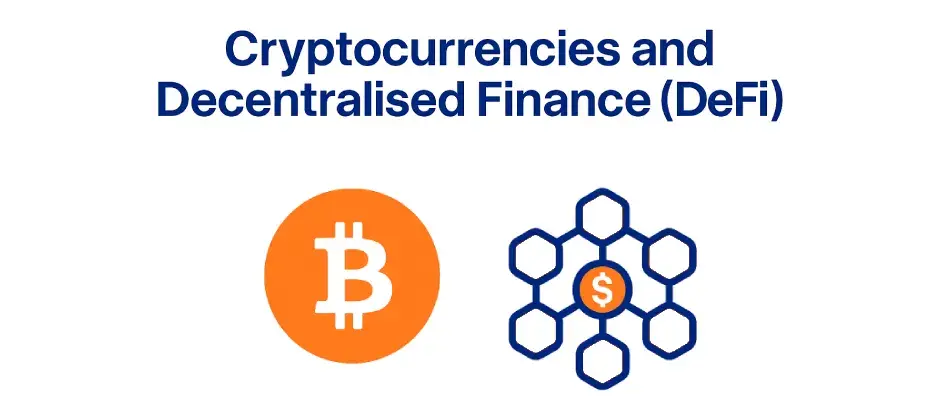
Cryptocurrencies and Decentralised Finance (DeFi) platforms
In recent years, cryptocurrencies and DeFi platforms have become one of the most challenging areas for AML compliance.
The attraction for criminals is obvious: transactions are fast, global, and in many cases provide a level of anonymity that traditional banking does not.
This combination makes them a powerful tool for layering illicit funds. The techniques vary:
Crypto mixers are services designed to scramble transactions so that tracing the origin of funds becomes nearly impossible.
Privacy coins such as Monero or Zcash go even further, building anonymity directly into their design.
Peer-to-peer platforms, users can move assets directly between wallets without going through regulated exchanges.
Regulators around the world, from FATF to FinCEN in the US and the European Banking Authority, are increasingly focused on these risks.
Investigations have shown how criminal groups combine different methods, moving funds through mixers, then into DeFi lending platforms, before cashing out through exchanges with weaker controls.
For compliance teams, the challenge is not only detecting suspicious flows in real time but also proving they took reasonable steps in a rapidly evolving environment.
Cash-intensive businesses
Cash-intensive businesses such as restaurants, nightclubs, or car washes remain a classic way to clean dirty money. Criminals simply mix large volumes of illegal money with the genuine cash flow these businesses generate every day.
In practice, this often looks like a bar inflating its reported takings, or a car wash declaring double the number of clients it could realistically handle.
Common red flags include businesses reporting much higher revenues than similar establishments or sudden expansion without a clear market reason.
Detecting this requires more than checking financial statements; site visits and benchmarking against industry averages are often the only way to spot when a company is being used as a front to clean dirty money.

Money mules
Criminals recruit individuals, knowingly or unknowingly, to move illicit money through their personal bank accounts or digital wallets.
Often promoted as “easy money jobs,” these schemes rely on ordinary people to transfer funds in small amounts, making detection harder.
Regulators such as Europol and FATF highlight money mules as a growing risk, particularly linked to online fraud and cybercrime.
Examples include:
Students or job seekers are paid to “process transactions” for a commission.
Accounts used to receive multiple small international transfers, which are then sent on quickly.
Use of family members or vulnerable people to hide the true controller of the funds.
This method blurs the line between victims and accomplices. In many cases, mules claim they did not know they were participating in money laundering schemes, but regulators still hold them accountable.
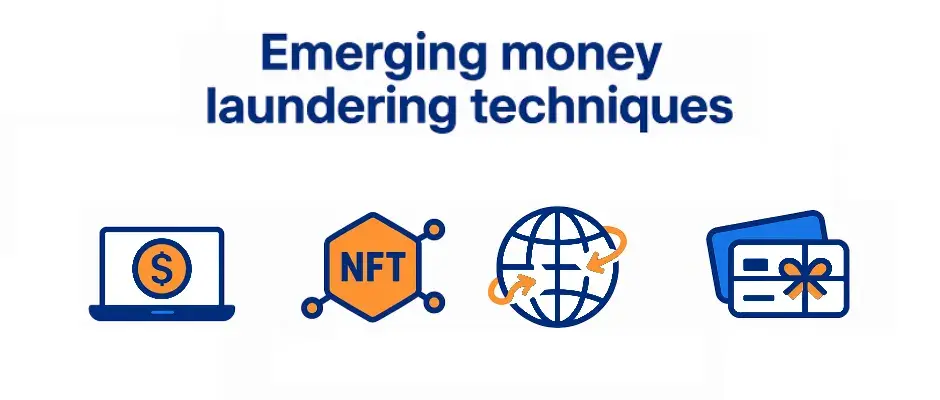
Emerging money laundering techniques
As financial oversight improves, criminals continually develop and refine more advanced laundering methods.
Digital laundering of assets
Digital currencies, exchanges, and blockchain wallets allow criminals to move money quickly, with a degree of anonymity that traditional banking does not provide. These features make digital asset laundering a growing concern.
Regulators have warned that crypto-related laundering is increasing, particularly where exchanges fail to apply proper KYC and transaction monitoring.
NFTs and blockchain assets
Non-fungible tokens (NFTs) are increasingly being misused to clean dirty money.
Criminals can buy and sell NFTs at artificially inflated prices, creating the illusion of legitimate value. Because NFT marketplaces often operate globally and with lighter oversight, tracking the real origin of funds becomes difficult.
A sudden rise in trading activity or inflated valuations are common red flags for investigators.
Layering through borders
Moving funds across countries with weaker AML regimes is a long-standing tactic.
Criminals take advantage of regulatory gaps by transferring money between jurisdictions until the original trail is obscured.
This cross-border layering often involves shell companies or multiple bank accounts, making international cooperation between FIUs essential to detection.
Prepaid and gift cards
Prepaid cards and gift cards are attractive for laundering because they are anonymous, easy to purchase, and widely accepted.
Criminals load cards with illicit funds and then use or resell them to introduce the money back into the economy.
Authorities in the US and EU have already limited card values and imposed stricter reporting rules, but regulators still flag large or repeated purchases of prepaid cards as a common warning sign.
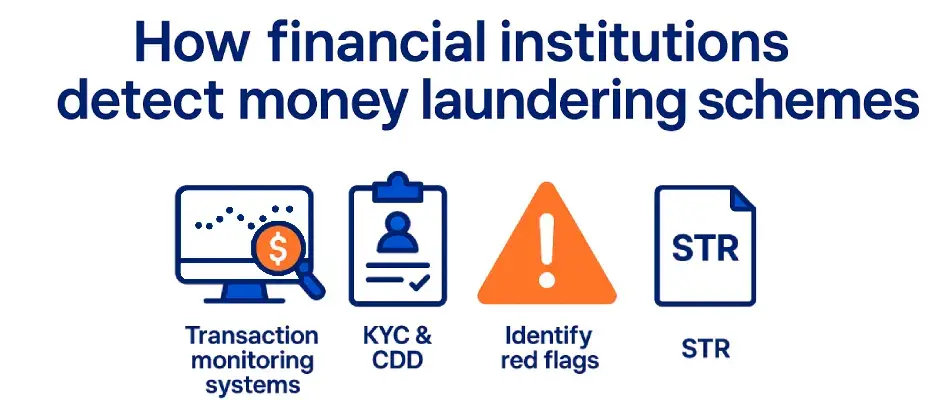
How financial institutions detect money laundering schemes
Financial institutions are the first line of defence against money laundering activities. They deploy sophisticated software to detect hidden money laundering activities in a particular account.
Transaction monitoring systems
Transaction monitoring systems automatically detect parameters of user operations and classify border activities as suspicious.
Know Your Customer (KYC) and Customer Due Diligence (CDD)
The verification of customer identities, beneficial ownership, and risk profile verification constitutes an important verification process.
To automate and make these processes more efficient, the use of a digital KYC solution is widely common and recommended across different companies.
Red flags
In businesses that face higher exposure to money laundering, employees need to know what to look out for; they have to know how to spot warning AML signs!
Typical red flags include unusually large cash deposits, frequent transfers across borders with no clear explanation, or clients who avoid providing even basic documents.
These may seem minor in isolation, but when seen together, they often signal behaviour worth escalating.
Suspicious Activity Reports (SARs) and Suspicious Transaction Reports (STRs)
It is an obligation of an institution to relay identified suspicious cases to the Financial Intelligence Units (FIUs), for the sake of investigation.
If you're not familiar with this, we recommend our guide on Suspicious Transaction Reporting, where you can learn everything you need about it.

Preventing and reporting money laundering
The responsibility of money laundering prevention lies in the hands of appropriate internal structures, enough awareness, and collaboration with relevant governing bodies.
Internal Anti-Money Laundering programmes
Financial institutions have the obligation to put in place the relevant framework with appropriate systems, and to carry out risk assessments in line with the governing laws of the land.
Employee training
Frontline workers have a crucial responsibility of detecting abnormal customer activities.
For this reason, it’s essential to provide effective Anti-Money Laundering training that equips staff with the knowledge and skills to recognise when someone is attempting to clean dirty money using different laundering methods.
Cooperation with Financial Intelligence Units (FIUs)
FIUs review reports and transmit information and analysis across borders.
Regulatory compliance
Widespread non-compliance or lack of adherence to the law will lead to fines, punitive measures, and damage to reputation.
This indicates the importance of Anti Money Laundering (AML) compliance, which is undeniable for any financial institution.
Most of the time, companies rely on regulatory compliance software to protect their businesses and make their lives easier.
The future of money laundering and AML
The ingenuity of criminals is constantly morphing, and so too are the responses of all institutions and countries.
AI and machine learning are enhancing the effectiveness of monitoring tools.
Regulations on cryptocurrencies are becoming more stringent everywhere.
Global data sharing between FIUs is enhancing international cooperation.
The future of AML will be defined by a balance between anticipating the next evolution of laundering typologies and optimising cross-border cooperation.

FAQs
What are the money laundering schemes involving banks?
Banks are usually victims during the placement and layering phases, where offenders inject dirty money into the bank, and later funnel it, via shell companies, through correspondent banks.
What are the money laundering schemes involving real estate?
Offenders purchase real estate by injecting dirty money into the economy, then sell the property for a price much higher than market value, or mask ownership through offshore entities.
What are the money laundering schemes in cryptocurrency?
Illegal funds are increasingly concealed using crypto mixers, DeFi platforms, privacy coins, and NFTs.
Conclusion
Money laundering is a highly sophisticated offence that has dire ramifications on a global scale.
Financial criminals adopt several schemes to launder money and exploit weaknesses in the system, from shell companies to cryptocurrencies that are tough to identify.
By understanding the stages of money laundering, recognising the common methods used to clean dirty money, and learning from real-world cases, professionals and the public can contribute to building stronger defences.
Vigilance, education, and international cooperation are the most effective tools we have against financial crime. Supporting AML initiatives helps protect economies, societies, and future generations.
Related articles






